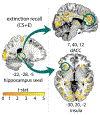Poor between-session recall of extinction learning and hippocampal activation and connectivity in children
- PMID: 30347237
- PMCID: PMC6286149
- DOI: 10.1016/j.nlm.2018.10.007
Poor between-session recall of extinction learning and hippocampal activation and connectivity in children
Abstract
Background: In healthy adults, successful between-session recall of extinction learning depends on the hippocampus and ventromedial prefrontal cortex (vmPFC), especially when tested in the extinction context. Poor extinction recall and dysfunction within hippocampal-vmPFC circuitry are associated with fear-based disorders (e.g., anxiety, posttraumatic stress disorder). Despite the early age of onset of virtually all fear-based disorders and the protracted development of the hippocampus and vmPFC across the first two decades of life, little is known about extinction recall and the underlying neural correlates in children.
Methods: Here, we tested extinction recall in 43 pre-adolescent children (ages 6-11 yrs) by coupling functional magnetic resonance imaging and virtual reality with a novel interpersonal threat-related two-day (ABBA) fear-extinction paradigm. Conditioned fear responding was assessed at behavioral, subjective, physiological, and neural levels.
Results: Although children demonstrated intact within-session extinction, there was poor between-session recall of extinction learning (retention index: 13.56%), evidenced by elevations in skin conductance, avoidant behavioral responses, and subjective ratings. Elevations in conditioning fear responding were accompanied by activation in the hippocampus and insula, and increased connectivity of the hippocampus with the insula and dorsal anterior cingulate cortex - regions implicated in the return of fear in adult studies. Children who kept more distance from the extinguished cue during extinction subsequently demonstrated heightened hippocampal-cingulate coupling during recall, suggesting that avoidant behavior interferes with extinction retention.
Conclusions: Poor extinction recall in children may have implications for developmental vulnerability to fear-based disorders, and for the application of therapeutic strategies that rely on principles of extinction (e.g., exposure therapy) to pediatric samples.
Keywords: Anterior cingulate cortex; Context; Extinction retention; Fear learning; Insula; fMRI.
Copyright © 2018 Elsevier Inc. All rights reserved.
Figures





Similar articles
-
Alterations in fear extinction neural circuitry and fear-related behavior linked to trauma exposure in children.Behav Brain Res. 2021 Feb 1;398:112958. doi: 10.1016/j.bbr.2020.112958. Epub 2020 Oct 15. Behav Brain Res. 2021. PMID: 33069739 Free PMC article.
-
Recall of fear extinction in humans activates the ventromedial prefrontal cortex and hippocampus in concert.Biol Psychiatry. 2007 Sep 1;62(5):446-54. doi: 10.1016/j.biopsych.2006.10.011. Epub 2007 Jan 9. Biol Psychiatry. 2007. PMID: 17217927
-
Skin Conductance Responses and Neural Activations During Fear Conditioning and Extinction Recall Across Anxiety Disorders.JAMA Psychiatry. 2017 Jun 1;74(6):622-631. doi: 10.1001/jamapsychiatry.2017.0329. JAMA Psychiatry. 2017. PMID: 28403387 Free PMC article.
-
Recalling safety: cooperative functions of the ventromedial prefrontal cortex and the hippocampus in extinction.CNS Spectr. 2007 Mar;12(3):200-6. doi: 10.1017/s1092852900020915. CNS Spectr. 2007. PMID: 17329980 Review.
-
Neural circuits for a top-down control of fear and extinction.Psychopharmacology (Berl). 2019 Jan;236(1):313-320. doi: 10.1007/s00213-018-5033-2. Epub 2018 Sep 13. Psychopharmacology (Berl). 2019. PMID: 30215217 Review.
Cited by
-
A study protocol testing pre-exposure dose and compound pre-exposure on the mechanisms of latent inhibition of dental fear.BMC Psychol. 2024 Jan 18;12(1):36. doi: 10.1186/s40359-024-01527-w. BMC Psychol. 2024. PMID: 38238866 Free PMC article.
-
Study protocol of an investigation of attention and prediction error as mechanisms of action for latent inhibition of dental fear in humans.BMC Psychol. 2023 Jan 25;11(1):23. doi: 10.1186/s40359-023-01054-0. BMC Psychol. 2023. PMID: 36698206 Free PMC article.
-
The role of cannabinoids in shaping lifespan neurodevelopment.J Neurosci Res. 2022 Mar;100(3):709-712. doi: 10.1002/jnr.25012. Epub 2022 Feb 2. J Neurosci Res. 2022. PMID: 35106825 Free PMC article. No abstract available.
-
A test of pre-exposure spacing and multiple context pre-exposure on the mechanisms of latent inhibition of dental fear: A study protocol.BMC Psychol. 2024 Feb 21;12(1):85. doi: 10.1186/s40359-024-01580-5. BMC Psychol. 2024. PMID: 38383546 Free PMC article.
-
Alterations in fear extinction neural circuitry and fear-related behavior linked to trauma exposure in children.Behav Brain Res. 2021 Feb 1;398:112958. doi: 10.1016/j.bbr.2020.112958. Epub 2020 Oct 15. Behav Brain Res. 2021. PMID: 33069739 Free PMC article.
References
-
- Craig AD (2009). How do you feel — now? The anterior insula and human awareness. Nature Reviews Neuroscience, 10(1), 59–70. https://doi.org/10.1038/nrn2555 - DOI - PubMed
-
- Åhs F, Kragel PA, Zielinski DJ, Brady R, & LaBar KS (2015). Medial prefrontal pathways for the contextual regulation of extinguished fear in humans. NeuroImage, 122, 262–271. https://doi.org/10.1016/j.neuroimage.2015.07.051 - DOI - PMC - PubMed
-
- Baker KD, & Richardson R (2015). Forming competing fear learning and extinction memories in adolescence makes fear difficult to inhibit. Learning & Memory, 22, 537–543. https://doi.org/10.1101/lm.039487.114 - DOI - PMC - PubMed
-
- Beckers T, Krypotos A-M, Boddez Y, Effting M, & Kindt M (2013). What’s wrong with fear conditioning? Biological Psychology, 92(1), 90–96. https://doi.org/10.1016/j.biopsycho.2011.12.015 - DOI - PubMed
-
- Blankenship SL, Redcay E, Dougherty LR, & Riggins T (2017). Development of hippocampal functional connectivity during childhood. Human Brain Mapping, 38(1), 182–201. https://doi.org/10.1002/hbm.23353 - DOI - PMC - PubMed

